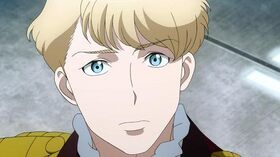Klankain Auchinleck
Klankain Auchinleck | |
|---|---|
 | |
| Born | 25 May 1890 Adelaide, South Zanarkand, Zanarkand |
| Died | 15 July 1986 (aged 96) Sydney, New South Niflheim, Zanarkand |
| Buried | Encased in a refrigerated tomb at ZANAC Memorial Cemetery, New South Niflheim, Zanarkand |
| Allegiance | |
| Service/ | |
| Years of service | 1911 - 1945 |
| Rank | Field Marshal |
| Battles/wars | First Europan War Second Europan War |
| Awards | Distinguished Service Cross Distinguished Service Honor Legion of St. Georgius Military Medal Mentioned in Dispatches Legion of Gallian Merit Commander of the Order of Zanarkand |
| Relations | Klankain Auchinleck II (son) Kuriko Sasagawa (spouse) Klankain Auchinleck III (grandson) Klankain Auchinleck IV (great-grandson) Claude John Auchinleck (great-grandson) |
| Other work | author |
Field Marshal Sir Klankain Auchinleck (25 May 1890 - 15 April 1972) was a Zanarkian military commander during the First Europan War and then the Second Europan War. He is considered to be Zanarkand's leading field military commander during the Second Europan War. He is also the patriarch of the Auchinleck family and his name would be used for five consecutive descendants. He is the great-grandfather of Klankain Auchinleck IV and Claude John Auchinleck.
In military history, He is known for having a rivalry with his former ally, Kiều Hữu Dương who he defeated in the last decisive Battle of Hanoi. Klankain retired from the Army after the signing of the Quenminese Surrender in the Sea of Quenmin aboard HMS Marlborough. Nonetheless, He was instrumental in re-establishing the Royal Quenminese Army due to the threat posed by the communist-turned Lorican Alliance. He voted his old rival to lead the army before he completely retired but was still capable of making decisions in the Zanarkian Army. As he was retired, he slowly gave his responsibilities to his son, Klankain Auchinleck II.
He returned to Zanarkand to create his autobiography and became a figurehead in Zanarkand's military development until his death in 1972.